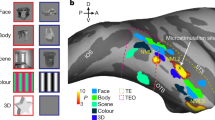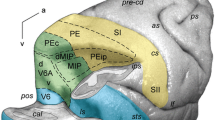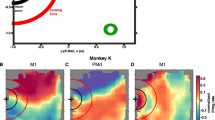Abstract
The macaque putamen contains neurons that respond to somatosensory stimuli such as light touch, joint movement, or deep muscle pressure. Their receptive fields are arranged to form a map of the body. In the face and arm region of this somatotopic map we found neurons that responded to visual stimuli. Some neurons were bimodal, responding to both visual and somatosensory stimuli, while others were purely visual, or purely somatosensory. The bimodal neurons usually responded to light cutaneous stimulation, rather than to joint movement or deep muscle pressure. They responded to visual stimuli near their tactile receptive field and were not selective for the shape or the color of the stimuli. For cells with tactile receptive fields on the face, the visual receptive field subtended a solid angle extending from the tactile receptive field to about 10 cm. For cells with tactile receptive fields on the arm, the visual receptive field often extended further from the animal. These bimodal properties provide a map of the visual space that immediately surrounds the monkey. The map is organized somatotopically, that is, by body part, rather than retinotopical ly as in most visual areas. It could function to guide movements in the animal's immediate vicinity. Cortical areas 6, 7b, and VIP contain bimodal cells with very similar properties to those in the putamen. We suggest that the bimodal cells in area 6, 7b, VIP, and the putamen form part of an interconnected system that represents extrapersonal space in a somatotopic fashion.
Similar content being viewed by others
References
Alexander GE (1987) Selective neuronal discharge in monkey putamen reflects intended direction of planned limb movements. Exp Brain Res 67:623–634
Alexander GE, DeLong MR (1985a) Microstimulation of the primate neostriatum. I. Physiological properties of striatal microexcitable zones. J Neurophysiol 53:1401–1416
Alexander GE, DeLong MR (1985b) Microstimulation of the primate neostriatum. II. Somatotopic organizationof striatal microexcitable zones and their relation to neuronal response properties. J Neurophysiol 53:1417–1430
Alexander GE, DeLong MR, Strick PL (1986) Parallel organization of functionally segregated circuits linking basal ganglia and cortex. Ann Rev Neurosci 9:357–381
Andersen RA, Essick GK, Siegel RM (1985) Encoding of spatial location by posterior parietal neurons. Science 230:456–458
Baizer JS, Ungerleider LG, Desimone R (1991) Organization of visual inputs to the inferior temporal and posterior parietal cortex in macaques. J Neurosci 11:168–190
Baker MA, Tyner CF, Towe AL (1971) Observations on single neurons recorded in the sigmoid gyri of awake, nonparalyzed cats. Exp Neurol 32:388–403
Battaglini PP, Fattori P, Galletti C, Zeki S (1990) The physiology of area V6 in the awake, behaving monkey. J Physiol 423:100P
Boussaoud D, Ungerleider LG, Desimone R (1990) Pathways for motion analysis: cortical connections of visual areas MST and FST in the macaque. J Comp Neurol 296:462–495
Bruce C, Desimone R, Gross CG (1981) Visual properties of neurons in a polysensory area in superior temporal sulcus of the macaque. J Neurophysiol 46:369–384
Caan W, Perrett DI, Rolls ET (1984) Responses of striatal neurons in the behaving monkey. 2. Visual processing in the caudal neostriatum. Brain Res 290:53–65
Caminiti R, Johnson PB, Urbano A (1990) Making arm movements within different parts of space: dynamic aspects in the primate motor cortex. J Neurosci 10:2039–2058
Cavada C, Goldman-Rakic PS (1989a) Posterior parietal cortex in rhesus monkey. I. Parcellation of areas based on distinctive limbic and sensory corticocortical connections. J Comp Neurol 287:393–421
Cavada C, Goldman-Rakic PS (1989b) Posterior parietal cortex in rhesus monkey. II. Evidence for segregated corticocortical networks linking sensory and limbic areas with the frontal lobe. J Comp Neurol 287:422–445
Cavada C, Goldman-Rakic PS (1991) Topographic segregation of corticostriatal projections from posterior parietal subdivisions in the macaque monkey. Neurosci 42:683–696
Colby CL, Duhamel J (1991) Heterogeneity of extrastriate visual areas and multiple parietal areas in the macaque monkey. Neuropsychologia 29:517–537
Colby CL, Duhamel J, Goldberg ME (1993) The ventral intraparietal area (VIP) of the macaque: anatomical location and visual response properties. J Neurophysiol 69:902–914
Crutcher MD, DeLong MR (1984a) Single cell studies of the primate putamen. I. Functional organization. Exp Brain Res 53:233–243
Crutcher MD, DeLong MR (1984b) Single cell studies of the primate putamen. I. Relations to direction of movement and pattern of muscular activity. Exp Brain Res 53:244–258
DeLong MR (1973) Putamen: activity of single units during slow and rapid arm movements. Science 179:1240–1242
Desimone R, Gross CG (1979) Visual areas in the temporal cortex of the macaque. Brain Res 178:363–380
Duhamel J, Colby CL, Goldberg ME (1991) Congruent representations of visual and somatosensory space in single neurons of monkey ventral intra-parietal cortex (area VIP). In: Paillard J (ed) Brain and space. Oxford University Press, New York, pp 223–236
Fogassi L, Gallese V, di Pellegrino G, Fadiga L, Gentilucci M, Luppino G, Matelli M, Pedotti A, Rizzolatti G (1992) Space coding by premotor cortex. Exp Brain Res 89:686–690
Gentilucci M, Scandolara C, Pigarev IN, Rizzolatti G (1983) Visual responses in the postarcuate cortex (area 6) of the monkey that are independent of eye position. Exp Brain Res 50:464–468
Gentilucci M, Fogassi L, Luppino G, Matelli M, Camarda R, Riz-zolatti G (1988) Functional organization of inferior area 6 in the macaque monkey. I. Somatotopy and the control of proximal movements. Exp Brain Res 71:475–490
Gross CG, Graziano MS (1990) Bimodal visual-tactile responses in the macaque putamen. Neurosci Abs 16:110
Graziano MS, Gross CG (1992a) Somatotopically organized maps of near visual space exist. Behav Brain Sci 15:750
Graziano MS, Gross CG (1992b) Coding of extrapersonal visual space in body-part centered coordinates. Neurosci Abs 18:593
Hyvarinen J (1981) Regional distribution of functions in parietal association area 7 of the monkey. Brain Res 206:287–303
Hyvarinen J, Poranen A (1974) Function of the parietal associative area 7 as revealed from cellular discharges in alert monkeys. Brain 97:673–692
Jay MF, Sparks DL (1987) Sensorimotor integration in the primate superior colliculus. II. Coordinates of auditory signals. J Neurophysiol 57:35–55
Jones EG, Powell TPS (1970) An anatomical study of converging sensory pathways within the cerebral cortex of the monkey. Brain 93:739–820
Jones EG, Coulter JD, Burton H, Porter R (1977) Cells of origin and terminal distribution of corticostriatal fibers arising in the sensory-motor cortex of monkeys. J Comp Neurol 173:53–80
Kemp JM, Powell TPS (1970) The cortico-striate projection in the monkey. Brain 93:525–546
Kimura M (1986) The role of primate putamen neurons in the association of sensory stimuli with movement. Neurosci Res 3:436–443
Kimura M, Rajkowski J, Evarts E (1984) Tonically discharging putamen neurons exhibit set-dependent responses. Proc Natl Acad Sci USA 81:4998–5001
Kunzle H (1975) Bilateral projections from precentral motor cortex to the putamen and other parts of the basal ganglia. An autoradiographic study in Macaca fascicularis. Brain Res 88:195–209
Kunzle H (1977) Projections from the primary somatosensory cortex to basal ganglia and thalamus in the monkey. Exp Brain Res 30:481–492
Kunzle H (1978) An autoradiographic analysis of the efferent connections from premotor and adjacent prefrontal regions (areas 6 and 9) in Macaca fascicularis. Brain Behav Evol 15:185–234
Leinonen L, Nyman G (1979) II. Functional properties of cells in anterolateral part of area 7 associative face area of awake monkeys. Exp Brain Res 34:321–333
Leinonen L, Hyvarinen J, Nyman G, Linnankoski I (1979) I. Functional properties of neurons in the lateral part of associative area 7 in awake monkeys. Exp Brain Res 34:299–320
Liles SL (1983) Activity of neurons in the putamen associated with wrist movements in the monkey. Brain Res 263:156–161
Liles SL (1985) Activity of neurons in putamen during active and passive movement of wrist. J Neurophysiol 53:217–236
Liles SL, Updyke BV (1985) Projection of the digit and wrist area of precentral gyrus to the putamen: relation between topography and physiological properties of neurons in the putamen. Brain Res 339:245–255
Matelli M, Camarda R, Glickstein M, Rizzolatti G (1986) Afferent and efferent projections of the inferior area 6 in the macaque monkey. J Comp Neurol 251:281–298
Maunsell JH, Van Essen DC (1983) The connections of the middle temporal visual area (MT) and their relationship to a cortical hierarchy in the macaque monkey. J Neurosci 3:2563–2856
Mays LE, Sparks DL (1980) Dissociation of visual and saccade-related responses in superior colliculus neurons. J Neurophysiol 43:207–232
Meredith AM, Stein BE (1985) Descending efferents from the superior colliculus relay integrated multisensory information. Science 227:657–659
Mesulam M, Van Hoesen GW, Pandya DN, Geschwind N (1977) Limbic and sensory connections of the inferior parietal lobule (area PG) in the rhesus monkey: a study with a new method for horseradish peroxidase histochemistry. Brain Res 136:393–414
Neal JW, Pearson RCA, Powell TPS (1988) The organization of the cortico-cortical connections between the walls of the lower part of the superior temporal sulcus and the inferior parietal lobule in the monkey. Brain Res 438:351–356
Paillard J (1991) Motor and representational framing of space. In: Paillard J (ed) Brain and space. Oxford University Press, New York, pp 163–184
Parthasarathy HB, Schall JD, Graybiel AM (1992) Distributed but convergent ordering of corticostriatal projections: analysis of the frontal eye field and the supplementary eye field in the macaque monkey. J Neurosci 12:4468–4488
Rizzolatti G, Berti A (1990) Neglect as a neural representation deficit. Rev Neurol (Paris) 146:626–634
Rizzolatti G, Scandolara C, Matelli M, Gentilucci M (1981a) Afferent properties of periarcuate neurons in macaque monkeys. I. Somatosensory responses. Behav Brain Res 2:125–146
Rizzolatti G, Scandolara C, Matelli M, Gentilucci M (1981b) Afferent properties of periarcuate neurons in macaque monkeys. II. Visual responses. Behav Brain Res 2:147–163
Rizzolatti G, Camarda R, Fogossi L, Gentilucci M, Luppino G, Matelli M (1988) Functional organization of inferior area 6 in the macaque monkey. II. Area F5 and the control of distal movements. Exp Brain Res 71:491–507
Robinson CJ, Burton H (1980a) Organization of somatosensory receptive fields in cortical areas 7b, retroinsular, postauditory, and granular Insula of M. fascicularis. J Comp Neurol 192:69–92
Robinson CJ, Burton H (1980b) Somatic submodality distribution within the second somatosensory area (SII), 7b, retroinsular, postauditory, and granular insular cortical areas of M. fascicularis. J Comp Neurol 192:93–108
Schlag J, Schlag-Rey M, Peck CK, Joseph JP (1980) Visual responses of thalamic neurons depending on the direction of gaze and the position of targets in space. Exp Brain Res 40:170–184
Schultz W, Romo R (1988) Neuronal activity in the monkey striatum during the initiation of movements. Exp Brain Res 71:431–436
Seltzer B, Pandya DN (1980) Converging visual and somatic cortical input to the intraparietal sulcus of the rhesus monkey. Brain Res 192:339–351
Sparks DL (1991) The neural encoding of the location of targets for saccadic eye movements. In: Paillard J (ed) Brain and space. Oxford University Press, New York, pp 3–19
Stanton GB, Cruce WLR, Goldberg ME, Robinson DL (1977) Some ipsilateral projections to areas PF and PG of the inferior parietal lobule in monkeys. Neurosci Lett 6:243–250
Ungerleider LG, Desimone R (1986) Cortical connections of visual area MT in the macaque. J Comp Neurol 248:190–222
Vogt BA, Pandya DN (1978) Cortico-cortical connections of somatic sensory cortex (areas 3, 1 and 2) in the rhesus monkey. J Comp Neurol 177:179–192
Weber JT, Yin TCT (1984) Subcortical projections of the inferior parietal cortex (area 7) in the stump-tailed monkey. J Comp Neurol 224:206–230
Author information
Authors and Affiliations
Rights and permissions
About this article
Cite this article
Graziano, M.S.A., Gross, C.G. A bimodal map of space: somatosensory receptive fields in the macaque putamen with corresponding visual receptive fields. Exp Brain Res 97, 96–109 (1993). https://doi.org/10.1007/BF00228820
Received:
Accepted:
Issue Date:
DOI: https://doi.org/10.1007/BF00228820




